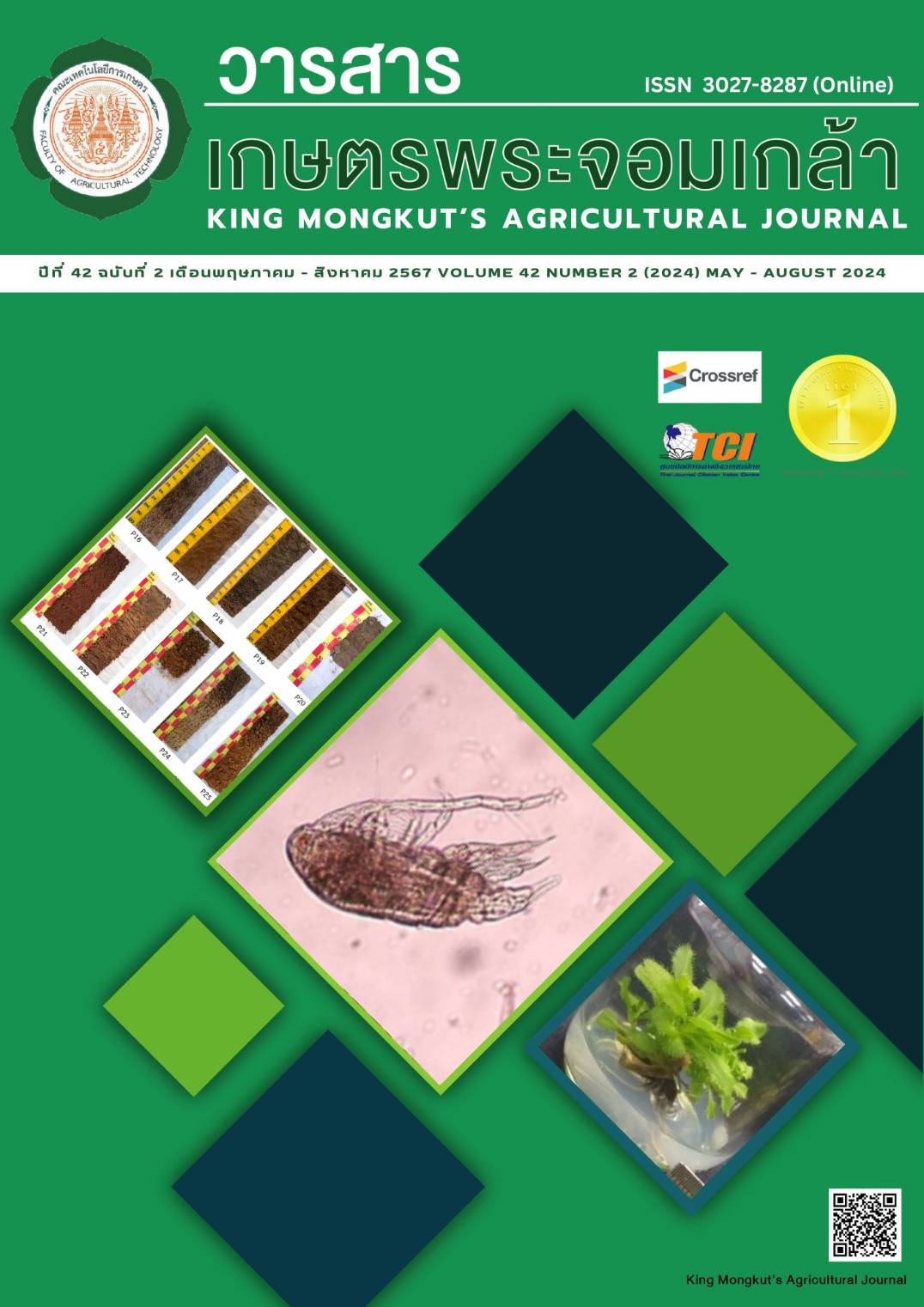Effect of Concentration and Frequency of Feeding with Food (Fermented Rice Bran) on Mass Culture of Natural Copepod
Main Article Content
Abstract
Development of natural copepod production using fermented rice bran at different concentrations and feeding frequencies was studied. The experiment followed a factorial design with two factors: rice bran concentration (50, 100, and 150 ppm) and feeding frequency (first feeding only and second feeding on day 4 after the first feeding). The experiment was conducted in 18 plastic buckets of 10-liter capacity for a duration of 30 days. The results showed that copepods responded to the increase and decrease in density in the same direction. The interaction between the two factors (rice bran concentration and feeding frequency) showed a significant influence on the copepod density (p<0.05). The highest copepod densities were observed when using first feeding only at a high rice bran concentration of 150 ppm (Mean±SE) of 6.4±1.4a ind./ ml. For the second feeding on day 4 after the first feeding, copepod densities were lower for all concentrations: (Mean±SE) 2.7±0.4, 2.4±0.3, 2.1±0.5 ind./ ml respectively. The most abundant types of copepods were from the orders Calanoid, Cyclopoid, and Harpacticoid copepod with percentages of 64.9, 23.3, 11.8 ind./ml, and the copepod stages were represented by nauplii, adult, copepodite, the adult with eggs. Their percentages were 38.9±2.0, 37.0±1.7, 23.6±1.4, 0.5±0.2 ind./ml, respectively. It can be concluded that using fermented rice bran at a high concentration of 150 ppm with the approach of first feeding only is sufficient enough to increase the mass culture of natural copepods.
Article Details

This work is licensed under a Creative Commons Attribution-NonCommercial-NoDerivatives 4.0 International License.
King Mongkut's Agricultural Journal
References
Aquamimicry. (2014). Protocol for an Extensive Aqua Mimicry Aquaculture: Natural Synbiotics Management ‘Extensive Culture). Retrieved from: https://baxelcompany.com
Chakravarty, S., Kumar, S., & Prakash, S. (2018). Back to the Basics: Biomimicry in Shrimp Farming. International Journal of Current Microbiology and Applied Sciences, 7(5), 2172-2184. https://doi.org/10.20546/ijcmas.2018.705.253.
De, Tailly. J-B. D. (2019). Study of an economical shrimp farming protocol aiming at improving control over water quality. Skretting a Nutreco Company. Retrieved from: http://creativecommons.org/licenses/by-nc-nd/4.0/deed.fr
Jepsen, M. P., Christina, V. T., Thibaut, Carron-Cabaret., Aleix, Pinyol-Gallemí., Søren, L. N., & Benni, W. H. (2018). Effects of salinity, commercial salts, and water type on cultivation of the Cryptophyte Microalgae Rhodomonas salina and the Calanoid Copepod Acartia tonsa. Journal of the World Aquaculture Society, 50(1), 104-118.
https://doi.org/10.1111/jwas.12508
Magouz, F. I., Essa, M. A., Matter, M., Tageldein Mansour, A., Alkafafy, M., & Ashour, M. (2021). Population Dynamics, Fecundity and Fatty Acid Composition of Oithona nana (Cyclopoida, Copepoda), Fed on Different Diets. Animals an Open Access Journal from MDPI, 11(5), 1188. https://doi.org/10.3390/ani11051188
Mubarak, A. S., Jusadi, D., Junior, M. Z., & Suprayudi, M. A. (2017). The population growth and the nutritional status of Moina macrocopa feed with rice bran and cassava bran suspensions. Journal Akuakultur Indonesia, 16(2), 223–233.
Nisar, U., Peng, D., Mu, Y., & Sun, Y. (2022). A Solution for sustainable utilization of aquaculture waste: a comprehensive review of biofloc technology and aquamimicry. Frontiers in Nutrition, 8, 791738. https://doi.org/10.3389/fnut.2021.791738
Romano, N., & Kumar, V. (2017). Vegetarian shrimp: Pellet-free shrimp farming. World Aquaculture, 48(4), 36-39.
Santhosh, B., Anil, M. K., Anzeer, F. M., Aneesh, K. S., Abraham, M. V., Gopakumar, G., George, R. M., Gopalakrishnan, A., & Unnikrishnan, C. K. (2018). Culture Techniques of Marine Copepods. ICAR-Central Marine Fisheries Research Institute, Kochi Kerala India.


